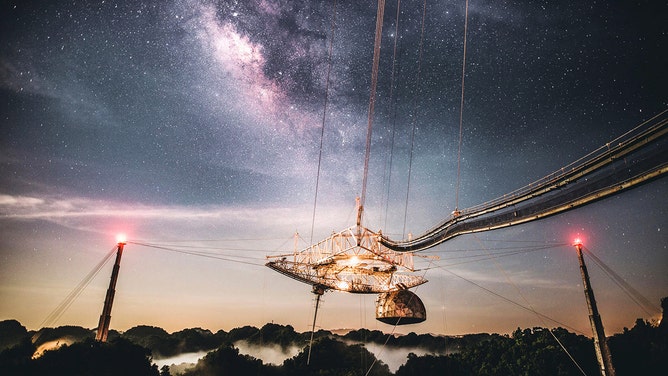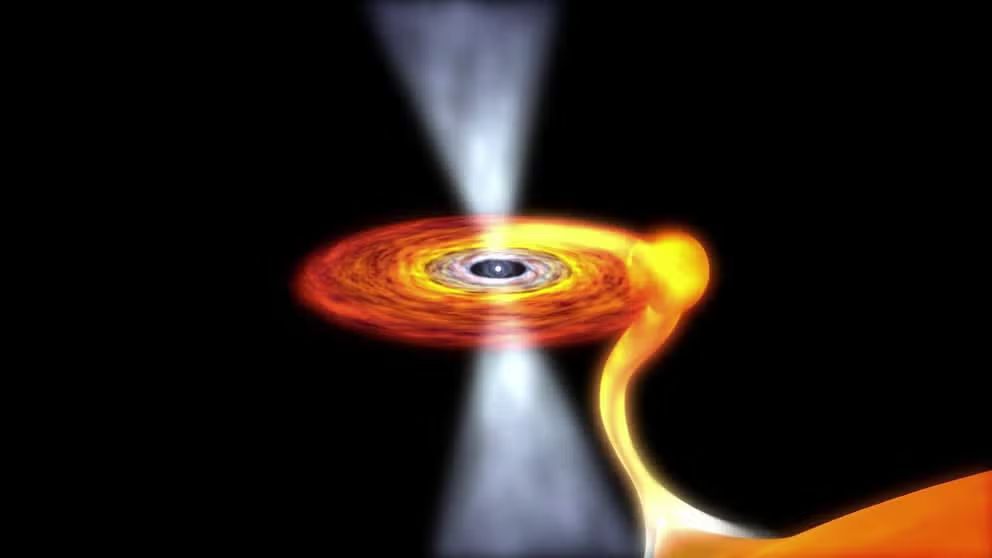World's second largest telescope helps search for tiny ripples in space-time
An international astronomy team is getting closer to confirming the next gravitational wave discovery—but on a much smaller scale.

File photo: A starry sky above the Arecibo Observatory in Puerto Rico. (Image credit: University of Central Florida)
An international astrophysics team is inching closer to making the next great gravitational wave discovery – but these ripples in space-time, which can be traced back to the big bang, are tiny and trickier to find.
The Arecibo Observatory in Puerto Rico is one of the radio telescopes around the world the team used to study the steady beats of pulsars or spinning neutron stars. They're looking for a slight wobble between Earth and the pulsar to confirm low-frequency gravitational waves exist.
"It's sort of like a hot topic in our community, detecting low-frequency gravitational waves, and everyone is aware of that we are getting there, and everyone is looking for detection. So, we have to be very careful," said Dr. Ben Perera, a University of Central Florida scientist at Arecibo and a member of gravitational waves study.
Arecibo is part of the North American Nanohertz Observatory for Gravitational Waves or NANOGrav and includes U.S. and Canadian team members. Partnering with researchers in Australia and Europe, the international group makes up the International Pulsar Timing Array or IPTA.
ASTEROID BIGGER THAN WORLD’S TALLEST BUILDING PASSES ‘NEAR’ EARTH -- BUT NO NEED TO PANIC
However, in December 2020, the 305-meter dish in Arecibo collapsed. It was the second-largest in the world. The mighty radio telescope was a significant loss to the scientific community worldwide.
Before the collapse, IPTA used the 1,000-foot telescope as one of its main instruments to observe more than 40 pulsars over 15 years.
The team is adapting to the loss of Arecibo by using longer observations from the C. Byrd Green Bank Telescope in West Virginia, which is part of NANOGrav.
"The GBT telescope is a 100-meter telescope. So, we had a 300-meter telescope versus a 100-meter telescope. What we have to do with the GBT observations, let's say, if we observe 10 minutes at Arecibo now, we have to observe half an hour at GBT. So you have to make the observation length longer at GBT to be able to get the same sensitivity."
A new spectrum of gravitational waves
Last week, the group published some of its findings on the potential gravitational waves showing strong evidence for a low-frequency signal associated with gravitational waves.
Combined data from the group are in agreement, showing gravitational wave "background," formed by many overlapping gravitational wave signals.
"This is a very exciting signal! Although we do not have definitive evidence yet, we may be beginning to detect a background of gravitational waves," said Siyuan Chen, head of IPTA's most recent data release search and publication.
For a long time, these ripples of space-time were theorized. Albert Einstein predicted their existence in 1916 with his theory of relativity. Decades later, the first evidence of a gravitational wave would come from a pulsar detected by Arecibo.
NASA'S NEW CHIEF SCIENTIST WILL INTEGRATE CLIMATE RESEARCH ACROSS AGENCY'S MISSION
The 2015 gravitational wave confirmation at the Laser Interferometer Gravitational-Wave Observatory or LIGO made international headlines and earned a Nobel Prize. However, there are multiple kinds of these waves that squeeze and pull apart space and time, characterized by their frequency.
The most substantial gravitational waves are produced by violent events in the universe, such as colliding black holes or massive stars exploding. By the time the waves reach Earth more than 1.3 billion light-years away, they are much, much weaker, generating wobble "1,000 times smaller than a nucleus of an atom," according to the LIGO Laboratory at the California Institute of Technology.
The waves discovered by LIGO were high-frequency, strong signals. The IPTA collaboration is searching for gravitational waves between nano Hertz to micro Hertz, using a very different method with radio observatories worldwide.
Using radio observatories, IPTA is specifically looking at the timing data or "pulse" as millisecond pulsars spin past the telescope's line of sight.
"It's sort of like a heartbeat recorder," Perera said of the periodic pulses.
Watch the NASA animation below to see a pulsar rotating between 1 and 10 milliseconds or 60,000 to 6,000 turns per minute.
NASA animation: Millisecond Pulsar with Magnetic Field Structure
This animation zooms into a neutron star and its accretion disk to show a millisecond pulsar in close-up. (NASA video)
As researchers monitor the rhythmic pulsars, they look for the slight "wobble" from the signature of a gravitational wave as it expands and stretches. The idea is that if you look at pulsars spread out across the sky, the same signal should be detected across all of them.
NOAA LAUNCHES NEW MAPS FOR LONG-RANGE TEMPERATURE AND PRECIPITATION OUTLOOKS
The hunt continues
To confirm low-frequency gravitational waves, two conditions need to be met, explained Perera. The pulsars must all have a common signal showing the gravitational wave, and the data must show a spatial correlation between the pulsars.
"So right now, we see a strong signal in all other pulsars, but we don't see a spatial correlation," Perera said.
The spatial correlation will improve with more observation time, Perera said.
If IPTA can confirm this new type of space-time ripple, it would expand our knowledge of the universe.
"By having this detection, you basically expand your gravitational wave spectrum. Right now, we know only the LIGO detected like a few hundreds of Hertz gravitational waves," Perera said. "Now we are trying to detect the low-frequency part, so sort of like expanding the gravitational wave spectrum, which is directly related to the evolution of galaxies and universe."
The international team must improve its sensitivity and length of observations to continue working toward its discovery. Another data release is expected in the next few years and with it the possible conclusive evidence of this new spectrum of gravitational waves.
